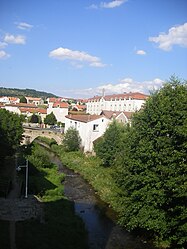Langogne
| Langogne | ||
|---|---|---|

A view of the river (Langouyrou) flowing through Langogne
|
||
|
||
| Coordinates: 44°43′40″N 3°51′21″E / 44.7278°N 3.8558°ECoordinates: 44°43′40″N 3°51′21″E / 44.7278°N 3.8558°E | ||
| Country | France | |
| Region | Occitanie | |
| Department | Lozère | |
| Arrondissement | Mende | |
| Canton | Langogne | |
| Government | ||
| • Mayor (2008–2020) | Guy Malaval | |
| Area1 | 31.37 km2 (12.11 sq mi) | |
| Population (1999)2 | 3,095 | |
| • Density | 99/km2 (260/sq mi) | |
| Time zone | CET (UTC+1) | |
| • Summer (DST) | CEST (UTC+2) | |
| INSEE/Postal code | 48080 / 48300 | |
| Elevation | 886–1,097 m (2,907–3,599 ft) (avg. 913 m or 2,995 ft) |
|
|
1 French Land Register data, which excludes lakes, ponds, glaciers > 1 km² (0.386 sq mi or 247 acres) and river estuaries. 2Population without double counting: residents of multiple communes (e.g., students and military personnel) only counted once. |
||
1 French Land Register data, which excludes lakes, ponds, glaciers > 1 km² (0.386 sq mi or 247 acres) and river estuaries.
Langogne is a commune in the Lozère department in southern France.
Located on the antique Regordane way, the Paris Nimes railway line and the road RN 88 (Lyon-Toulouse), the city has long been a commercial crossroad between the Auvergne , the Cévennes and the Languedoc.
It is one of the gateways of the historic county of Gévaudan and now of the recently created (2016) “Occitanie” region.
Langogne is situated in the valley of the Allier, in a mountainous area. It is crossed by the Langouyrou stream that joins the Allier in the north of the commune. The city is overlooked by some mountains : Margeride,Mount Milan (Beauregard), Bonjour Volcano .
The name appears in the corpus of Gaulish toponymy.
Mount Milan that is surrounding the city could have been an oppidum (as seems to prove the findings of Roman medals, coins and weapons). It might have been the meeting area of the Gabali tributes that joined Vercingetorix’s army in their struggle against Caesar.
In the Early Middle Ages, the territory belonged to the Viguerie of Miliac, one of the eight composing the Gevaudan.
The city itself was founded in 998 by the monks of le Monastier. The medieval town, built around the monastery, took benefit of the Regordane to become an important centre of trade. The stream allows the development of the wool and the textile industry.
During the Wars of Religions, the town was plundered in 1568 by the Huguenot troop of captain Merle. The hunting of the Beast of Gévaudan started in Langogne in 1764. During the Revolution, many religious items were destroyed by fire in the centre of the town 1793.
...
Wikipedia



